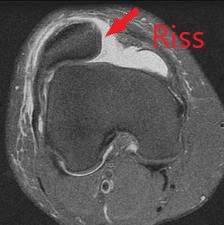Patellar Dislocation – Kneecap Dislocation
 In the case of a patellar dislocation, the kneecap (patella) spontaneously jumps out of the groove due to an unfavorable movement or is dislodged by direct trauma. The former variant is clearly predominant. In most cases, the kneecap moves back into its original position on its own. Only in rare cases does it remain in the dislocation position on the outside of the knee joint. Patellar dislocation often results in cartilage damage.
In the case of a patellar dislocation, the kneecap (patella) spontaneously jumps out of the groove due to an unfavorable movement or is dislodged by direct trauma. The former variant is clearly predominant. In most cases, the kneecap moves back into its original position on its own. Only in rare cases does it remain in the dislocation position on the outside of the knee joint. Patellar dislocation often results in cartilage damage.
Factors favoring spontaneous patellar dislocation:
- Knock-knee position
- Weak inner thigh extensor muscles (Musculus vastus medialis)
- Congenital malformations of the patella or the patellar groove
- High-riding patella
- Rotational position of the knee joint
Patellar dislocation diagnosis
A kneecap dislocation is diagnosed clinically. X-rays rule out bony injuries. MRI can detect cartilage damage.
How is a patellar dislocation treated?
A patellar dislocation can result in a shear fracture in the area of the inside of the kneecap. A bone-cartilage fragment can break off. In this case, a knee specialist should perform an operation as quickly as possible. The sheared fragment is positioned and fixed with resorbable implants. The faster the procedure is performed, the better the healing.
If there is no bone-cartilage fragment after a patellar dislocation, you can opt for conservative therapy. In this case, however, it must be ensured that there are no contributing factors, as otherwise the chances of healing without another dislocation are slim.
If there are contributing factors, surgery is also appropriate for the first-time dislocation of the kneecap.
In the case of surgery, I clarify whether the growth plates near the knee joint are still open or already closed.
If the kneecap repeatedly jumps out of the groove, the reconstruction of the mediopatellofemoral ligament can be carried out minimally invasively under arthroscopic control. The triangular band, which runs between the inside of the kneecap and the femur, is replaced by an autologous tendon.
Likewise, a relocation of the patellar tendon insertion can be promising.
A trochleoplasty (= kneecap groove reshaping operation) may be necessary in special cases, as well as a correction of a knock-knee malalignment.
I tailor the appropriate therapy individually to each patient.
What does the aftercare for a patellar dislocation look like?
After the operation, you will wear a motion splint for 6 weeks and bend the knee only up to 90°. Weight-bearing on the leg is permitted. The healing process is supported by physiotherapy started immediately after the operation. Sport is possible again 3 months after the operation.

Dr. Mark Schurz
CONTACT